This all about scallops guide will help answer any questions you might have about this popular seafood ingredient. There are quite a few simple tips when selecting, cleaning, and storing fresh and frozen sea scallops, and these vary depending on whether you are buying your sea scallops fresh or frozen. Ideally, we could all enjoy fresh sea scallops, but we will start with a few basics on scallop varieties and sizes.
Sea scallops are exceptional for pan-seared scallops, hibachi scallops, and my delicious breaded stuffed scallops recipes!
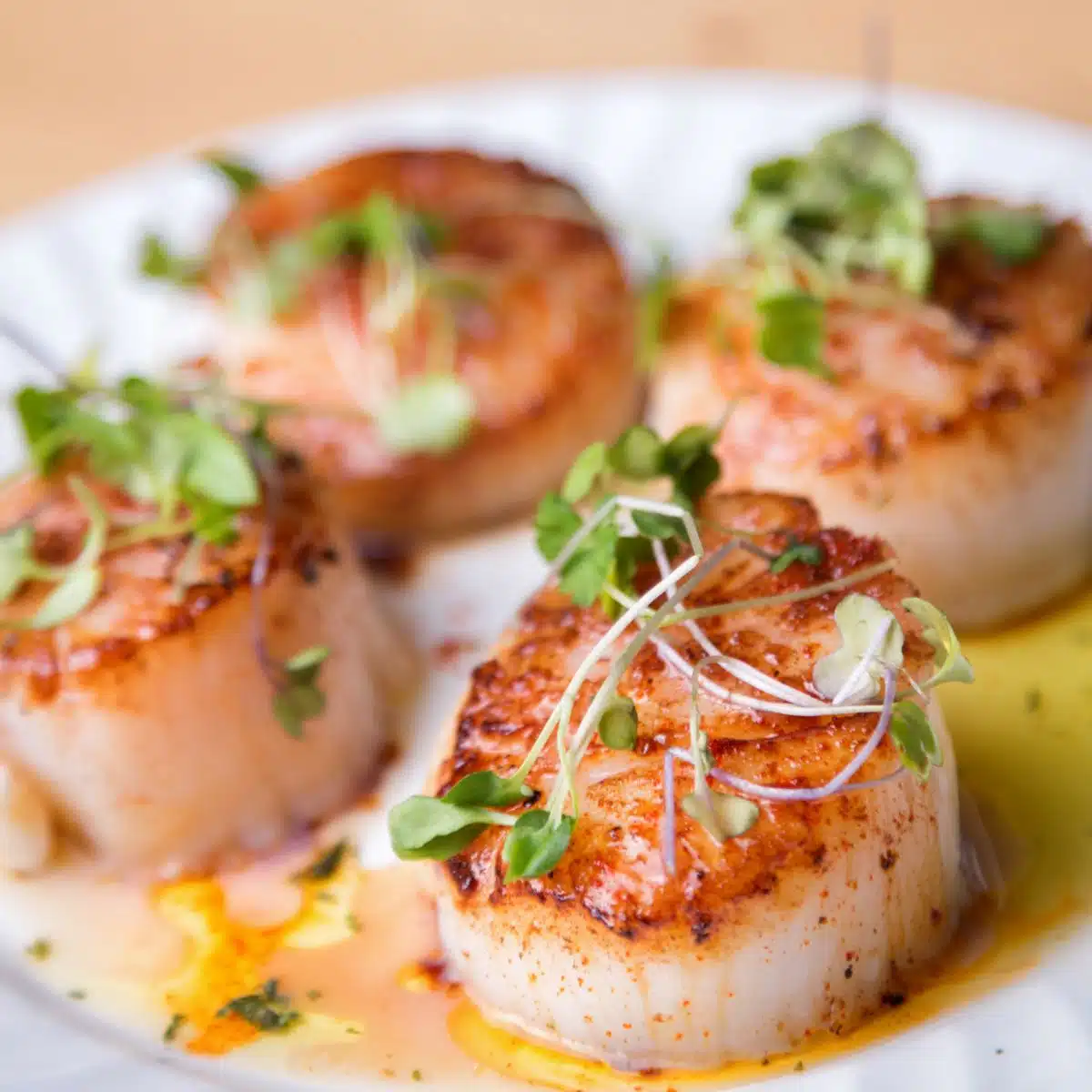
Jump to:
- Bay Scallops (Argopecten Irradians)
- Sea Scallops (Placopecten Magellanicus)
- Calico Scallops (Argopecten Gibbus)
- Sustainability and Harvesting
- Nutritional Benefits
- Cooking Tips for Perfect Scallops
- Sustainable Sourcing
- What Are Diver and Dayboat Scallops?
- Diver Scallops
- Dayboat Scallops
- Scallop Sizes
- How Many Per Package
- Selecting Frozen Sea Scallops
- Selecting Fresh Sea Scallops
- Wet vs Dry Scallops: Which is Best?
- Storing & Freezing
- Thawing
- Conclusion
- 📖 Recipe Card
- 💬 Comments & Reviews
Learn how to discern the quality of scallops, whether browsing the frozen aisle or selecting fresh catch.
I will walk you through everything you need to know, from different sizes to harvesting methods and even several varieties. I'll even give you tons of tips for storing them so you don't have to sacrifice their flavor, quality, or freshness.
Bay Scallops (Argopecten Irradians)
Bay scallops are a small variety that usually only measures about half an inch in diameter. They have a well-loved sweet flavor and perfectly tender texture.
You can find them in bays and shallow waters along the East Coast of the United States.
Since they are small and sweet, they are fantastic for recipes in which you want them to be the star of the show. They cook quickly, too.
Try them in chowders, pasta dishes, or even just lightly sauteed.
Sea Scallops (Placopecten Magellanicus)
Sea scallops can be as large as two inches in diameter. The texture is firmer than the bay scallops and they also have a somewhat sweet flavor.
As the name suggests, this variety comes from deeper and colder waters. You can specifically find this type in the North Atlantic ocean, ranging from Newfoundland to North Carolina.
The larger size of these makes them great for tossing on the grill, baking, or pan-searing. In fact, they are a common choice for bold recipes, like scallop risotto, grilled skewers, or as an addition to your favorite salads.
Calico Scallops (Argopecten Gibbus)
Calico scallops are about the same size as bay scallops (about half an inch in diameter). They get their name from their colorful shells and have a slightly firm texture.
You can find this variety in the coastal waters of the Southeastern United States, ranging from North Carolina to Florida (and even into the Gulf of Mexico).
They are pretty versatile and can be used in a similar way to the bay scallops. Try adding them to mixed seafood dishes, casseroles, or lightly saute them with some butter and herbs.
Sustainability and Harvesting
It's important to choose seafood that is sustainable. This means that it is harvested using a method that protects both the species itself as well as the ecosystem.
You should always try to buy ones that have been harvested in sustainable ways. For example, diver-caught ones are more sustainable than ones caught by dredging.
Of course, the availability of your scallops is not always the same. Sea scallops are available all year long, while bay scallops are typically only harvested in fall and winter.
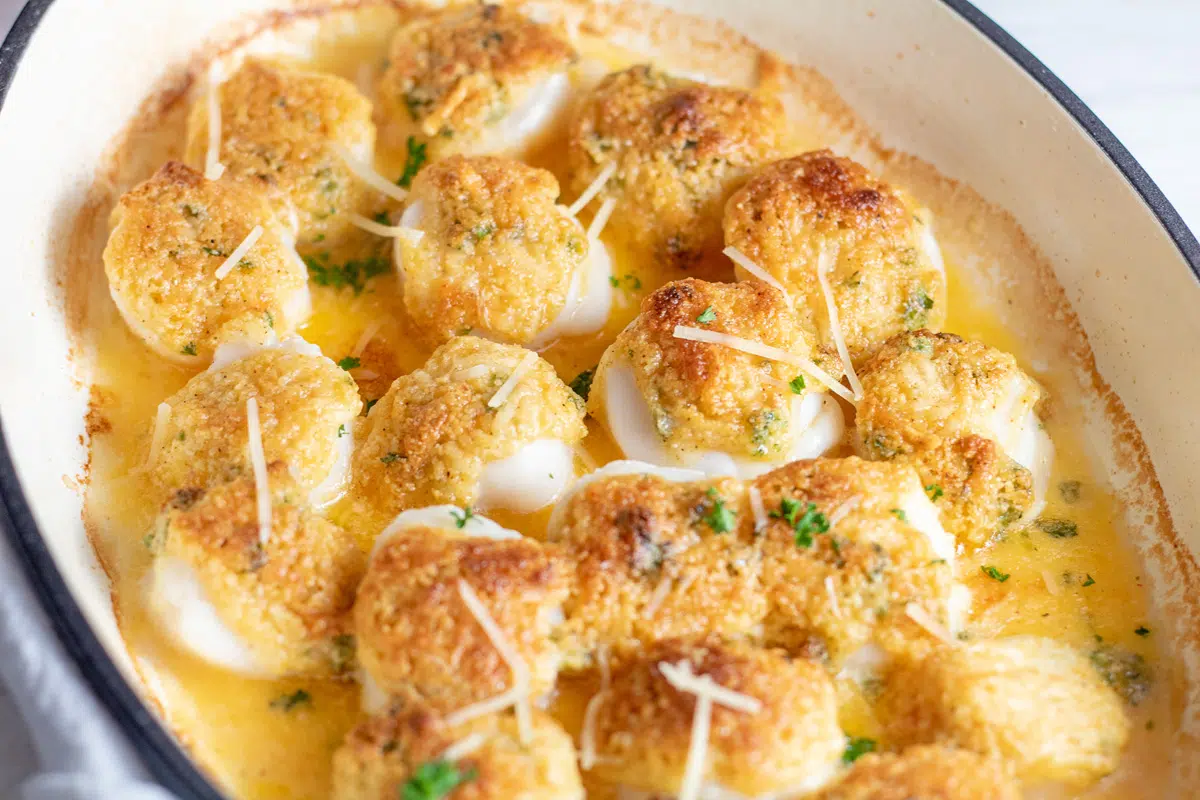
Nutritional Benefits
- Rich in Protein. They are a fantastic source of lean protein, which is great for muscle building and repair.
- Low in Fat. These make a great low-fat protein choice, which is also low in calories!
- Heart Health. Since they are high in omega-3 fatty acids, they can help to improve the overall health of your heart.
- Minerals and Vitamins. They are a good source of minerals like magnesium, potassium, and B vitamins.
Cooking Tips for Perfect Scallops
- Avoid Overcooking. Overcooked scallops are both tough and rubbery. They actually cook pretty quickly, so a quick sear for just 1-2 minutes should be enough.
- Seasoning. They have a pretty mild flavor. Because of this, they pair wonderfully with herbs and spices.
- Complementary Pairings. They taste great with tons of different things. Try them with some creamy sauces, citrusy dressing, or keep it simple with some fresh herbs.
See my post for ideas on what to serve with scallops.
>>>See All Of My Tasty Recipes Here!<<<
Sustainable Sourcing
- Eco-Friendly Choices. Choose ones certified by sustainable seafood organizations. Look for labels like MSC (Marine Stewardship Council) or ASC (Aquaculture Stewardship Council).
- Local and Seasonal. If you want the freshest available, make sure you choose ones that are both local and in season.
What Are Diver and Dayboat Scallops?
These are two additional names for sea scallops that are sometimes confused for types. However, the names 'diver' and 'dayboat' both refer to how they are harvested.
Diver Scallops
Diver scallops are different varieties of scallops that have been hand-harvested by scuba divers. This method is both more sustainable and more environmentally friendly than dredging.
You'll also find that they are typically larger in size and even have a higher quality. This is because the divers are hand-picking the scallops themselves.
Scallops harvested by divers have a fresher, more sweet flavor with a tender texture. Without having to deal with the stress of dredging, they can easily maintain their quality.
Of course, since this harvesting method requires more labor, they are usually more expensive.
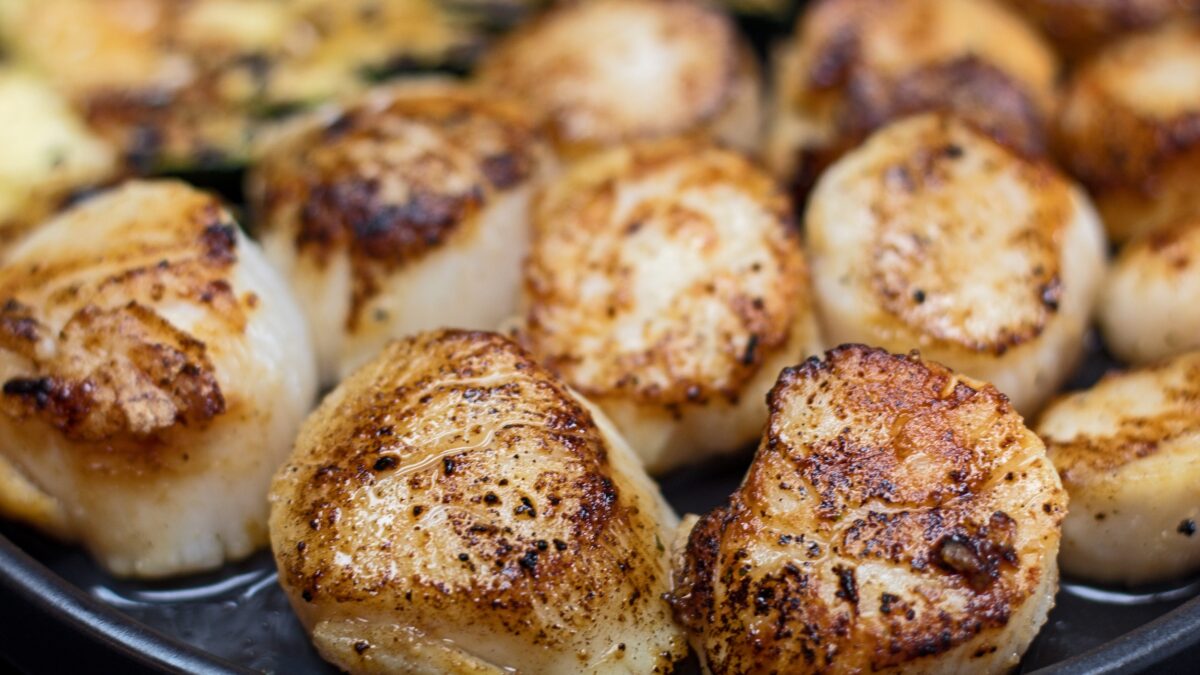
Dayboat Scallops
As opposed to diver scallops, dayboat scallops are ones that are harvested and returned within a single day, typically by dredging. This is when a dredge is drug along the ocean floor by a boat in order to capture them (as well as other sea creatures).
Since dayboats return them in a single day, you'll know that they are always fresh. Unfortunately, dredging is not environmentally friendly since it disturbs the sea floor so much.
Choosing Between Diver and Dayboat Scallops
- Consider Sustainability. If environmental impact is a concern, Diver Scallops are a more sustainable choice.
- Taste and Culinary Use. Both types are excellent for gourmet dishes, but Diver Scallops might offer a slight edge in terms of flavor and texture due to their selective harvesting.
- Availability and Price. Diver Scallops can be harder to find and more expensive, while Dayboat Scallops are more widely available but still offer a fresher alternative to scallops harvested on longer fishing trips.
Scallop Sizes
For the two most common varieties sold commercially here in the States, there are many sizes to choose from! Select your type based on your recipe, then choose the size.
There are typically 70-120 bay scallops or scallop meats per pound. As shown in the chart below, the sizes are broken down by how many you will get per pound.
| Package Size | Bay Scallops Per Package | Size of Bay Scallops |
| 40/60 | 40-60 per pound | Roughly ¾-inch in diameter |
| 60/80 | 60-80 per pound | Roughly ¾-inch in diameter |
| 80/100 | 80-100 per pound | Between ½ to ¾-inch in diameter |
| 80/120 | 80-120 per pound | Between ½ to ¾-inch in diameter |
| 120/150 | 120-150 per pound | Roughly ½-inch in diameter |
| 150/200 | 150-200 per pound | Roughly ½-inch in diameter or smaller |
- There are anywhere from 8 to 50 sea scallops or meats per pound.
- Packages of fresh or frozen sea scallops labeled as U/8, U/10, U/12, or U/15 are the largest. The 'U' indicates 'under' 8 scallops per pound for U/8, or 'under' 10 scallops in a U/10 scallops package per pound, etc.
- In addition to U packages, they are also sold in package sizes of 10/20, 20/30, 30/40, and 40/50.
How Many Per Package
Sea scallop sizes are broken down by how many you will get per pound, as shown in the chart below.
| Package Size | Sea Scallops Per Package | Size of Sea Scallops |
| U/8 | Up to 8 | Between 2½ - 2¾ inches in diameter |
| U/10 | Up to 10 | Roughly 2½ inches in diameter |
| U/12 | Up to 12 | Between 2¼ - 2½ inches in diameter |
| U/15 | Up to 15 | Between 2 - 2¼ inches in diameter |
| 10/20 | Between 10-20 | Roughly 2 inches in diameter |
| 20/30 | Between 20-30 | Between 1½ - 1¾ inches in diameter |
| 30/40 | Between 30-40 | Between 1½ - 1¾ inches in diameter |
| 40/50 | Between 40-50 | Roughly 1½ inches in diameter |
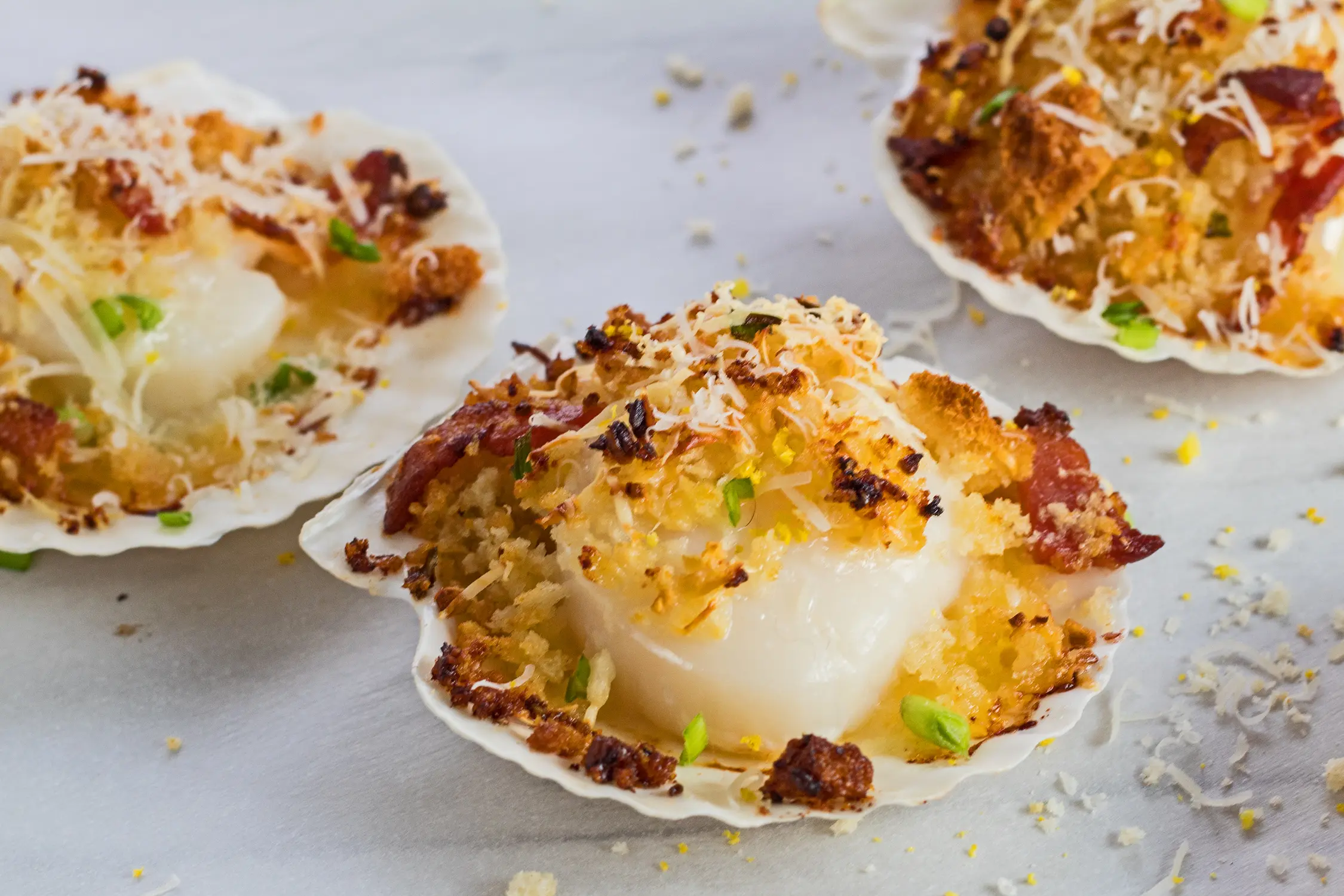
Selecting Frozen Sea Scallops
If buying online, one of the most important things is to buy from a reputable seafood supplier. As with selecting frozen seafood in the store, once your package arrives, inspect the packaging for the following:
- Whether or not the packaging is open anywhere.
- Check to see if the packaging is crushed.
- Inspect the scallops for signs of frost or ice crystals.
This last item would indicate that perhaps the scallops have been frozen for quite a while or thawed and refrozen, which can easily happen during shipping. If any of these are apparent on your selected frozen shipment, contact the seller for replacement.
- If you buy frozen scallops in the store, check the packaging for the signs noted above.
- When purchasing in the store, there is product placement. Packages above the frost line, which is at the top of the freezer case, should be avoided.
- While shopping, make your seafood selection the last item you select at the store ( whether fresh or frozen ). The package should be evenly cold, and there should be no 'fishy' odors. Look for flash-frozen, if available.
Selecting Fresh Sea Scallops
Dry-packed, chemical-free, diver-caught, and dayboats are the preferred choice and generally offer better quality. Check your label for how they were handled, and look for these terms as a start!
Wet vs Dry Scallops: Which is Best?
Short answer. The dry scallops are the best between the two. Hands down! And for so many reasons.
***This is a general answer, as any packaged variety could be compromised in quality. However, when shopping, I would buy dry scallops daily over wet.
- Dry do not have the added water weight you are paying for.
- Dry are not packaged with sodium tripolyphosphate (STP), which can also be used to soak scallops before freezing!
- Wet will release excess moisture during cooking. This results in soggy breaded scallops and a not-so-great pan-seared scallop.
- The moisture makes the wet scallops tougher and less flavorful when cooked.
The most commonly found variety available in stores are wet-packed, which are plump and filled with moisture (typically a brine or STP mentioned above).
***Not all fresh are necessarily of better quality than frozen!
>>>See All Of My Tasty Recipes Here!<<<
Storing & Freezing
When storing your purchased frozen sea scallops (or fresh scallops), store them in the refrigerator if you intend to cook and eat them within 2 days.
Otherwise, wrap them tightly in plastic cling wrap, aluminum foil, or moisture-proof freezer paper for longer storage. If you are not preparing them soon, unpack and store them immediately in the coolest location in your freezer.
Thawing
Thaw your frozen scallops by placing them in the refrigerator to thaw overnight. If you need to thaw them quickly, place them in a plastic bag and put them in cool running water.
Do not thaw them in warm or hot water, at room temperature, or in the microwave. Thawing in the microwave will quickly turn to cooking them, resulting in rubbery scallops. Yuck!
Also, thawed scallops should not be left at room temperature for more than two hours. I recommend no more than one hour, especially during summer and hot weather.
Conclusion
When it comes to cooking, scallops are pretty versatile. They cook quickly and can be a great addition to various dishes, from pasta to salads.
They're delicious and a cool way to connect with the ocean's bounty. Happy cooking, and enjoy exploring the diverse and delicious world of seafood! 🌊🍳🐚
Do you love a recipe you tried? Please leave a 5-star 🌟rating in the recipe card below and/or a review in the comments section further down the page.
Stay in touch with me through social media @ Pinterest, Facebook, Instagram, or Twitter! Subscribe to the newsletter today (no spam, I promise)! Don't forget to tag me when you try one of my recipes!
📖 Recipe Card
All About Scallops Guide: Sizes, Storage, Tips, & More!
Ingredients
- 6-10 sea scallops
- 1 tablespoon olive oil (extra virgin)
- ½ teaspoon each, salt & pepper (to taste)
- 1 tablespoon butter
- ½ lemon (zested and squeezed)
(Note: 2x or 3x only changes the ingredient list)
Instructions
- Preheat your skillet, non-stick frying pan, or cast-iron skillet to medium-high heat with olive oil. Your oil should begin to shimmer and start to smoke at this heat when it is ready for the scallops.
- Rinse and pat the sea scallops dry. You want them to be as dry as possible for the best sear.
- Season the dry scallops with salt and pepper right before placing them into your preheated skillet. Place the scallops with the seasoned side down, leaving spacing between the scallops. Then season the upward-facing side of the scallops.
- Sear the scallops for 2 minutes without moving the scallops. *This interrupts the searing.
- Use tongs to flip the scallops and sear the second side for 1 minute.
- Add the butter and a squeeze of lemon, then spoon the melted butter over the searing scallops in the last minute of cooking time.
- Once the second side is seared, remove the scallops from the skillet and transfer them to plates to serve. Garnish with zested lemon and parsley.
Notes
- There are a couple of things to note before starting, and these will help to prevent any mistakes! Firstly, you want your pan and oil to be fully heated. The oil should not only be shimmering but also on the verge of smoking. If not actually smoking a bit.
- Secondly, you want to place your scallops with enough room between them so that they can cook evenly. Crowded scallops will tend to boil more than sear. We don't want this!
- Once cooked, it is important to not only remove your pan from heat but also to transfer the scallops to your serving plate. *The heat from the pan will continue to cook the scallops if set aside.
- And last but definitely NOT LEAST. Do not move your scallops while they are cooking. The searing process would be interrupted if you wanted to move or check your scallops during the cooking time. Plus, your seared meats will release from the cooking surface when they are done. Trust the process.
Nutrition
Originally published June 17, 2016

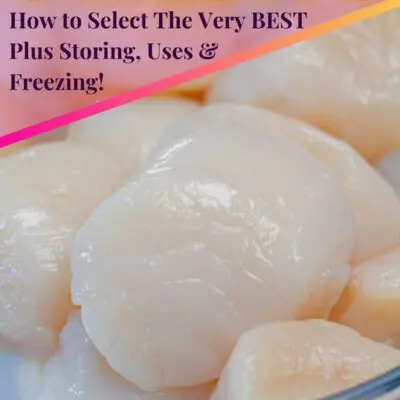
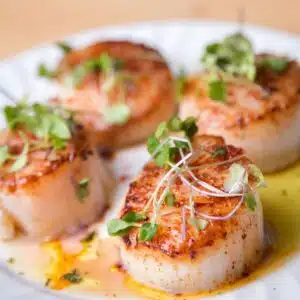
Comments
No Comments